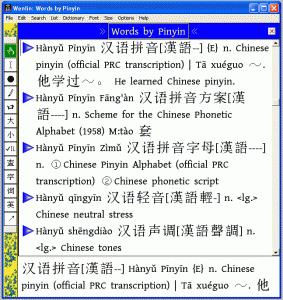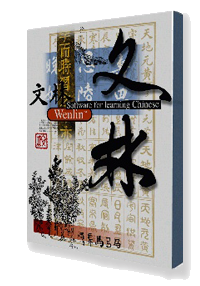 One of my favorite programs, Wenlin (which bills itself as “software for learning Chinese”), has just released a major upgrade for both Mac and Windows versions. This doesn’t happen often; it has been three-and-a-half years since the most recent big change was issued (Wenlin 3.4) and heaven only knows how long since 3.0 came out. So, yes, this release has many substantial improvements.
One of my favorite programs, Wenlin (which bills itself as “software for learning Chinese”), has just released a major upgrade for both Mac and Windows versions. This doesn’t happen often; it has been three-and-a-half years since the most recent big change was issued (Wenlin 3.4) and heaven only knows how long since 3.0 came out. So, yes, this release has many substantial improvements.
One of the features nearest and dearest to my heart is that Wenlin 4.0 features greatly improved handling of Pinyin. I was among the field testers for the new version, so I’ve already spent a lot of time examining this feature. Here are a few important aspects of this:
- Conversions from Chinese characters follow Hanyu Pinyin orthography much more closely than before. This is a major change for the better. (There’s still some room for improvement. But I don’t think we’ll have to wait years for this.)
- In the past, using Wenlin to convert long texts in Chinese characters into Pinyin could be a real chore, with users having to examine example after example of Chinese characters with multiple pronunciations in order to select the proper pronunciation for that particular context. But now users may, if they so desire, tell Wenlin not to ask users for disambiguation input. Of course, that doesn’t mean that Wenlin will always guess right; but many users will be happy that this trade-off allows them to skip the frustration of, for example, having to tell the program over and over and over that, yes, in this case 說 is pronounced shuō rather than shuì.
- Relative newcomers to Mandarin may appreciate that for common words tone sandhi is indicated in Wenlin with additional marks (a dot or line below the vowel). This feature can also be turned off, for those who want standard Pinyin.
There are, of course, many improvements beyond the area of Pinyin. Here are a few:
- One limitation of Wenlin 3.x was that its English dictionary wasn’t very large. But Wenlin 4.0 includes not only the ABC Chinese-English Comprehensive Dictionary but also the excellent new ABC English-Chinese, Chinese-English Dictionary (now finally in stock in the printed version).
- The flashcards are now set up to handle not just individual characters but polysyllabic words.
- There’s full Unicode Unihan 6.0 support for more than 75,000 Chinese characters.
- And for those who think 75,000 just isn’t enough, users can now access Wenlin’s CDL technology. Through this, users can create new, variant, and rare characters; moreover, these can be published and shared with other Wenlin users or CDL-friendly devices.
- Seal script versions of more than 11,000 characters are provided.
- Wenlin contains an e-edition of the Shuowen Jiezi (Shuōwén Jiězì / 說文解字 / 说文解字).
- Coders will be interested to know that Wenlin appears to be headed toward becoming open-source.
- Both Mandarin and English entries are marked with grade levels, which aids learners by indicating relative frequency of use. The levels for Mandarin words are based on the Hanyu Shuiping Kaoshi (Hànyǔ Shǔipíng Kǎoshì / 汉语水平考试 / 漢語水平考試 / HSK).
The full version (i.e., the CD with the program comes in a box and is likely packaged with a hard copy of the manual) is US$199, or US$179 if you download it from the Wenlin Web store. Upgrades from 3.x cost US$49.
For more information, see the summary of features and outline of what’s new in Wenlin 4.0.




